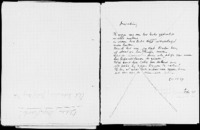Pierre Kemp
Item set
Title
Pierre Kemp
Description
en
Collection of Maastricht-born Pierre Kemp (1886-1967). It contains various types of objects, such as books (his personal library), letters, manuscripts, radio fragments, graphic work, a Liber Amicorum (a handwritten book of friends including graphic work by well-known artists), vinyl records, a red egg decorated by him with a poem in gold ink, a desk, and a record cabinet.
nl
Een van de meest fascinerende eenlingen in de twintigste-eeuwse Nederlandse poëzie is de in Maastricht geboren Pierre Kemp (1886-1967). In 1956 ontving hij de Constantijn Huygensprijs, in 1958 gevolgd door de P.C. Hooft-prijs. De Universiteitsbibliotheek Maastricht beheert een groot deel van zijn persoonlijke nalatenschap. In de Pierre Kemp Collectie bevinden zich diverse soorten objecten, zoals boeken (zijn privébibliotheek), brieven, manuscripten, radiofragmenten, grafisch werk, een Liber Amicorum (een handgeschreven vriendenboek inclusief grafisch werk van bekende kunstenaars), vinylplaten, een rood ei versierd met een gedicht in goudinkt, een bureau en een platenkast. Een deel van deze collectie is in de bibliotheek ondergebracht door de Pierre Kemp Stichting, die tot doel heeft Kemps literaire en grafische erfgoed onder de aandacht van een breed publiek te brengen. Als onderdeel van het landelijke programma Verbonden Digitaal Erfgoed wil de Universiteitsbibliotheek de Pierre Kemp Collectie zo gelinkt, open en verrijkt mogelijk presenteren aan een zo breed mogelijk publiek.
De collectie Pierre Kemp wordt op verschillende manieren beschikbaar gesteld (CC-BY-licentie):
• voor mensen via deze website;
• als Linked Open Data in machineleesbaar JSON-LD formaat of SPARQL endpoint;
• als datasetregistratie in het NDE-datasetregister.
De collectie Pierre Kemp wordt op verschillende manieren beschikbaar gesteld (CC-BY-licentie):
• voor mensen via deze website;
• als Linked Open Data in machineleesbaar JSON-LD formaat of SPARQL endpoint;
• als datasetregistratie in het NDE-datasetregister.
Identifier
ark:/27364/d18jZzz
Items
13 items
-
Egg for Turquoise - Ei voor Turkoois
A virtual 3D reconstruction of an artificial red coloured Easter egg decorated with a poem in gold ink by Pierre Kemp for his muse Turkoois, the name he gave to a 21-year old jurist he had met on the train on April 15, 1942 Transcribed text in Dutch: Dit ei is rood van vreugde dat ’t nooit advocaat kan worden en niet die struif en gin bevat als ’t schrikbewind der Orde en geen nieuw leven door een broed aan schrikbewindje geven moet. -
Prélude à l’Après-midi d’un faune en Nocturnes
Claude Achille Debussy’s 1892 Prelude to the Afternoon of a Faun inspired Pierre Kemp to write his poem Zingende Daad. Kemp’s record collection holds a 1932 recording by the Walther Straram Orchestra conducted by Walther Straram. -
Menuet des follets
Hector Berlioz’s 1846 Menuet des Follets (from La Damnation de Faust, Op. 24) inspired Pierre Kemp to write his poem Van der Kleuren. Kemp’s record collection holds a 1932 recording by French Orchestre de l'Association des Concerts Lamoureux, conducted by Albert Wolff. -
Pavane pour une Infante défunte
Maurice Ravel’s 1899 Pavane pour une Infante défunte inspired Pierre Kemp to write his poem Gramophone DB 4930. Kemp’s record collection holds a 1932 recording by the Orchestre Symphonique, conducted by Freitas Branco. -
Daphnis et Chloé. Première Suite: 1. Nocturne.
Maurice Ravel’s 1912 Première Suite: 1. Nocturne (from Daphnis et Chloé) inspired Pierre Kemp to write his poem Gramophone DB 4930. Kemp’s record collection holds a 1934 recording by the Orchestre de la Société des Concerts du Conservatoire, conducted by Piero Coppola. -
Les Festes de Thalie
Jean-Joseph Mouret’s 1714 Les Festes de Thalie inspired Pierre Kemp to write his poem Elegie om het verlies van Amaranth. Kemp’s record collection holds a 1951 recording by the Orchestre de la Société des Concerts de Versailles, conducted by G. Cloez. -
Oak office desk
A virtual 3D reconstruction of one of the oak office desks at which Pierre Kemp wrote his poems in his house in the Turennestraat 21 in Maastricht, where he lived from 1929 until his death in 1967. -
Record cabinet
A virtual 3D reconstruction of the record cabinet in which Pierre Kemp kept his records, some of which directly inspired his poetry.













